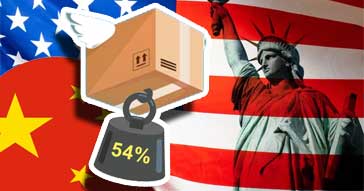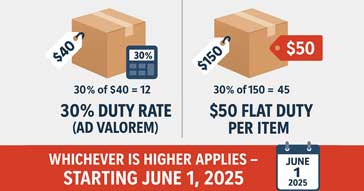Trump’s New Tariffs on Chinese Imports: How Will This Impact American Shoppers on AliExpress, Temu, and SHEIN? Tariffs on Chinese goods.

Update: Tariff Hike to 125% (April 9, 2025)
In a sharp escalation of the U.S.–China trade conflict, President Donald Trump raised tariffs on Chinese imports to 125% on April 9, 2025. The move came just hours after China increased duties on American goods to 84%, intensifying tensions and raising concerns about major disruptions to global trade flows
Update: New Tariff Increase Announced (April 9, 2025)
President Trump has introduced an updated trade measure in response to China’s retaliatory tariff announcements. As of April 9, 2025, the U.S. has raised tariffs on most goods imported from China to 104%
Bye-Bye Bargains? Decoding Trump’s New China Tariffs for Online Shoppers
Trump’s New Tariffs: The End of Cheap AliExpress & SHEIN Hauls?
Are your days of snagging ultra-cheap deals from AliExpress and other global marketplaces numbered? A seismic shift in US trade policy is underway, and it’s poised to directly impact your online shopping experience.
April 2nd, 2025, dubbed “Liberation Day” by President Trump, marks a significant hardening of the US stance on international trade, particularly concerning goods originating from China. The most immediate and impactful change for online shoppers is the elimination of the de minimis exemption for Chinese goods, effective May 2nd, 2025. This means those under-$800 hauls that often sailed through customs duty-free are about to face a new reality.
How the U.S. Will Charge 30% or $50 Duty on Chinese Imports Starting May 2025
What Exactly is Changing?
Previously, the Section 321 de minimis rule allowed shipments valued at $800 or less to enter the US without customs duties, import taxes, or tariffs. This was a boon for e-commerce platforms like AliExpress, Temu, and SHEIN, enabling them to offer a vast array of affordable products directly to American consumers.
Here’s a breakdown of the key changes:
- End of Duty-Free for Low-Value Chinese Goods: Starting May 2nd, 2025, the duty-free threshold of $800 for goods originating from China and Hong Kong is eliminated for shipments by private carriers (like FedEx, DHL, UPS). These shipments will now be subject to standard import taxes.
- New Taxes on Postal Shipments: Even items worth $800 or less sent through the international postal system will face a new tax: either 30% of their value or a flat fee of $25 per item (increasing to $50 after June 1st, 2025).
- Soaring Tariff Rates: This isn’t just about losing the duty-free status. China already faces a 20% tariff on imports, in addition to existing tariffs that can range from 7.5% to a staggering 100%. With an additional 34% duty imposed earlier this year, the total tariff rate on Chinese goods now stands at a hefty 54%.
Why the Change?
The official narrative, as indicated by the provided text, is to “combat China’s role” and take a “new stance on international trade.” The Trump administration views these tariffs as a way to protect American industries, address trade imbalances, and potentially encourage domestic production.
What Does This Mean for You, the American Online Shopper?
The implications for American consumers who frequently shop on platforms like AliExpress are significant:
- Higher Prices: The most direct impact will be an increase in the cost of goods. Sellers will likely have to pass on at least a portion of these new tariffs and taxes to consumers to maintain their profit margins. That $10 gadget or $20 fashion top might suddenly cost considerably more.
- Fewer Bargains: The allure of deep discounts that often characterizes these platforms may diminish. The competitive edge gained by avoiding tariffs will be largely eroded.
- Potential Shipping Delays and Complexity: The elimination of de minimis means all shipments will require formal customs entries, leading to more paperwork, potential delays, and increased logistical complexities. This could translate to longer wait times for your orders.
- Shift in Product Availability: Some sellers might choose to stop shipping certain low-value items to the US altogether if the added costs and complexities make it unprofitable. This could lead to a reduced selection of goods.
- Consideration of Alternatives: American consumers might start looking more closely at domestic retailers or brands from other countries that are not subject to these high tariffs.
A Look at the Numbers: The Impact on a Single Purchase
Let’s consider a hypothetical example of a product purchased on AliExpress:
- Product Price: $50
- Previous Scenario (Before May 2nd, 2025): Under the $800 de minimis rule, this item likely entered the US duty-free (assuming shipped by a private carrier). The final cost to the consumer would be around $50 (plus shipping).
- New Scenario (After May 2nd, 2025):
- Tariff (54%): $50 * 0.54 = $27
- Potential Import Taxes/Fees: Additional fees might apply depending on the specific item and customs procedures. Let’s assume a nominal $5 for simplicity.
- Total Cost (excluding initial shipping): $50 (product) + $27 (tariff) + $5 (fees) = $82
In this simplified example, the cost of a $50 item could increase by over 60% due to the new tariffs.
Predictions and Considerations:
- AliExpress and Other Platforms Will Adapt: These platforms have a vested interest in the US market. They will likely explore various strategies to mitigate the impact, such as:
- Encouraging sellers to establish warehouses in the US to avoid tariffs on goods already within the country.
- Adjusting pricing strategies and potentially absorbing some of the initial cost increase.
- Improving logistics and customs clearance processes.
- Small Sellers Will Be Hit Hardest: Smaller Chinese sellers who rely heavily on direct-to-consumer shipping of low-value goods will face the biggest challenges. They may lack the resources to absorb the increased costs or navigate complex customs procedures.
- US Consumers Will Re-evaluate: The price sensitivity of consumers who shop on these platforms will be tested. Will they be willing to pay significantly more for the same goods? Will they seek out alternatives?
- Potential for Increased Domestic Consumption: The higher cost of imported goods could, in theory, lead to a slight increase in demand for domestically produced goods, if available.
- China’s Response: As indicated in the provided text, China is strongly opposed to these tariffs and has vowed to take “counter-measures.” The nature of these counter-measures could further complicate the international trade landscape.
Who Pays the Price?
- Consumers: Expect 10–60% price hikes on cheap goods from China.
- Sellers: Profit margins will shrink unless they raise prices or relocate supply chains.
- Logistics: Shipping times could double due to customs bottlenecks.
The Future of Cross-Border E-Commerce
- Short-term pain: A surge in abandoned carts as buyers balk at new fees.
- Long-term shifts:
- More U.S. fulfillment centers (to bypass tariffs).
- Rise of non-Chinese suppliers (India, Southeast Asia).
- Temu & SHEIN may pivot to local manufacturing.
What Should Shoppers & Sellers Do?
To adapt, both consumers and businesses will need to explore new strategies:
✅ Stock up now before May 2 price hikes.
✅ Shoppers can look for U.S.-based warehouses on AliExpress or Temu to avoid high tariffs.
✅ Check country of origin (tariffs apply to where it’s made, not shipped from).
✅ Sellers: Explore US 3PLs (third-party logistics) to avoid delays.
✅ Sellers may consider relocating stock to the U.S. to bypass direct import duties.
✅ Retailers might explore alternative sourcing from non-tariffed countries.
Will Chinese Marketplaces Lose Their American Shoppers?
With rising costs, American consumers might shift their shopping habits. Some may turn to U.S.-based alternatives like Amazon, Walmart, or Target for faster shipping and no surprise import fees. Others may look for resellers based in the U.S., who import Chinese goods in bulk and distribute them domestically.
Will Chinese Sellers Find a Way Around These Rules?
Many Chinese businesses are already exploring alternative strategies, such as:
- Setting up U.S. warehouses to store inventory and avoid direct cross-border shipping.
- Shipping from non-Chinese locations (e.g., using fulfillment centers in Mexico, Canada, or Europe).
- Relying on dropshipping networks that disguise the country of origin.
Could Prices on Amazon and eBay Increase Too?
Yes. Many third-party sellers on Amazon, eBay, and Etsy source their products from China. With the new tariffs, these sellers will likely pass the extra costs onto buyers, leading to higher prices even on American platforms.
Conclusion: The End of an Era for Ultra-Cheap Online Shopping?
The elimination of the de minimis exemption and the imposition of significant tariffs on Chinese goods mark a turning point for American consumers who have grown accustomed to the affordability offered by platforms like AliExpress. While these platforms will likely adapt, the era of snagging incredibly cheap deals without considering import duties appears to be drawing to a close. American shoppers should brace themselves for higher prices, potential shipping delays, and a re-evaluation of their online shopping habits.
Official US Government Resources:
- U.S. Customs and Border Protection (CBP): Search “CBP de minimis” on the official CBP website: cbp.gov
- Office of the United States Trade Representative (USTR): ustr.gov
- Fact Sheet: President Donald J. Trump Declares National Emergency to Increase our Competitive Edge, Protect our Sovereignty, and Strengthen our National and Economic Security
Disclaimer: This article provides an analysis based on the provided information and current understanding of the situation. Trade policies are subject to change, and consumers are advised to stay informed about the latest developments. The example calculation is a simplification and actual costs may vary.

